Constructing an ‘Ideal Nationality’ in Poetry and Glass: Emilio Villa, the Bardis, and the Collaborative Making of the São Paulo Museum of Art
Jennifer Scappettone
Apr 29, 2015
(6pm)
Talk
Please RSVP
In conjunction with our current exhibition Lina Bo Bardi: Together, Jennifer Scappettone will present her recent research on the collaborative and cross-disciplinary making of the Sao Paulo Museum of Art (MASP) in the 1940s-60s. Scappettone will track the radical efforts of curation by museum director Pietro Maria Bardi, architect and designer Lina Bo Bardi, and the poet Emilio Villa on the inaugural exhibitions for the museum, with an eye to how their supranational reach and montage of prehistoric and modernist aesthetics impacted both contemporary art criticism and the poetry of the neo-avant-garde. MASP’s unique “didactic” exhibitions, which featured objects, photographs, documents, and texts displayed in floating glass easels designed by Lina Bo Bardi, aimed to forge a newly global art history and to educate the New World public without academic pretense—in the interest of enacting what director P. M. Bardi called the “collaboration of all human forces,” generating no less than “the democratic formation of modern man.”
Jennifer Scappettone is a poet, translator, and scholar with particular interests in the reciprocal interference of language, architecture, and public space. She is the author of Killing the Moonlight: Modernism in Venice (Columbia University Press, 2014) and of the poetry collection From Dame Quickly (Litmus, 2009); she edited and translated Locomotrix: Selected Poetry and Prose of Amelia Rosselli (University of Chicago Press, 2012), and curated Belladonna Elders Series 5: Poetry, Landscape, Apocalypse (Belladonna, 2009). Exit 43, a cross-genre work on toxic archaeologies and salvage, is in progress for Atelos Press, with a web-based installation forthcoming in collaboration with Judd Morrissey. She is an associate professor at the University of Chicago.
Image: Installation of the Didactic Expositions at the São Paulo Art Museum (MASP), 1947-8. Vitrine structures by Lina Bo Bardi; content by Emilio Villa, Pietro Maria Bardi, and collaborators. Courtesy Archives of the Library of the São Paulo Art Museum (MASP).
For more information on the exhibition, Lina Bo Bardi: Together, click here.

Opening Reception: Lina Bo Bardi: Together
Apr 24, 2015
(5:30pm)
Opening Reception
Please RSVP
Please join us for a reception to celebrate the opening of our spring exhibition Lina Bo Bardi: Together. Paying tribute to the influential Italian-born Brazilian architect Lina Bo Bardi, this exhibition presents new works by artist Madelon Vriesendorp, filmmaker Tapio Snellman, and photographer Ioana Marinescu that together inspire new conversations around Bo Bardi's work by capturing the experience of her buildings and her inclusive approach to design.
Curated by Noemí Blager and designed by London-based Assemble, Lina Bo Bardi: Together is sponsored by Arper, which has produced Bardi's Bowl Chair (1951) in a limited edition of 500 in collaboration with Instituto Lina Bo e P. M. Bardi in São Paulo on the occasion of the centennial of Bo Bardi's birth.
Friday, April 24
5:30pm: Comments by curator Noemí Blager, Madelon Vriesendorp, and Tapio Snellman
6-8pm: Opening Reception
Noemi Blager is an architect and curator from Buenos Aires, Argentina, who is now based in London. She is former acting director of the Architecture Foundation in London and member of the Design Museum's curatorial committee. Blager is advisor of the Lina Bo Bardi Fellowship, a project initiated by the British Council to create long-term connections between British and Brazilian artists, designers, and architects. In 2003, Blager collaborated with OMA on the exhibition Content, presented in Germany and the Netherlands. She is the culture and development consultant at the Italian design company Arper. She has been a guest lecturer at the Institut für Kunst und Architektur, Vienna; Kingston College, London; and ESADE, Barcelona; as well as tutor of architectural design at the University of Buenos Aires.
Madelon Vriesendorp co-founded the Office for Metropolitan Architecture (OMA) with Rem Koolhaas and Elia and Zoe Zenghelis. Her paintings have been used for numerous book and magazine covers, notably Delirious New York (1978) by Rem Koolhaas. Her work has been exhibited at the Serpentine Gallery (London), Guggenheim Museum and Max Protetch galleries (New York), Centre Pompidou (Paris), Stedelijk Museum (Amsterdam), Aedes Gallery (Berlin), Gallery Ma (Tokyo), Architectural Association (London), and the 2008 Venice Architecture Biennale. Vriesendorp’s work is included in the permanent collections of the Museum of Modern Art, The Canadian Center for Architecture, and Frac Lorraine, France. Since the mid-1980s, she has taught art and design at the Architectural Association, London, and Edinburgh School of Art.
Tapio Snellman is a filmmaker, artist, and architect engaged in architectural and urban discourse. His work includes film installations, commercial moving images, experimental 3D animation, and site-specific projections for museums, theater, and dance. He has had long-term collaborations with creators, such as Herzog & de Meuron, Zaha Hadid, OMA, David Adjaye, and Sasha Waltz on film, animation, and performance projects. Snellman received degrees in Architecture and City Planning from the University of North London and Universität Stuttgart, and currently holds a lecturing position at the University of Innsbruck, Austria. His films and installations have been exhibited at numerous venues, including The Victoria & Albert Museum, Tate Modern, The Hayward Gallery, and The Design Museum, London; the Guggenheim Museum, New York; the Kiasma Museum of Contemporary Art, Helsinki; and at several iterations of the Venice Architecture Biennale.
Ioana Marinescu is a London-based artist working with photography. She studied architecture in Romania and the UK before turning to photography. Her work has been shown at the Architectural Association and RIBA, London; the Cité du patrimoine et de l’architecture, Paris; the Kunsthalle Exnergasse, Vienna; and the Canadian Centre for Architecture, Montreal. Marinescu teaches architecture at Kingston University in London and runs regular workshops and lectures on photography and architecture. Her PhD at the Slade School of Fine Art is concerned with the relationship between cities and memory.
Assemble is a young architecture and design practice based in London. Founded by a collective of 18 members, its work covers a broad range of disciplines, mediums and interests. Through a collaborative working practice Assemble explores design ideas, testing unexpected and imaginative uses of materials and construction. Previous projects range from an experimental theatre space to affordable housing development. Assemble has exhibited internationally, and numerous awards include the Bauwelt international architecture prize (2013) and the New London Architecture Awards (2012). The setting for this exhibition has been designed by Assemble to be a re-enactment of the experience of Lin Bo Bardi’s work.
Arper is a furniture design company based in Treviso, Italy, and is the main sponsor of Lina Bo Bardi: Together.
Instituto Lina Bo e P. M. Bardi in São Paulo, Brazil, is open to the public and holds the archives of Lina Bo Bardi and Pietro Maria Bardi.
Image: Tapio Snellman, SESC Pompeia, still, 2012. Courtesy of the artist.
For more information on the exhibition, Lina Bo Bardi: Together, click here.

Project of a Historical Architecture–Wonders of the Modern World: America
Pier Paolo Tamburelli
Apr 07, 2015
(6pm)
Talk
Please RSVP
On Tuesday, April 7, Italian architect, writer, and editor Pier Paolo Tamburelli will present the research that he recently conducted as the Douglas A. Garofalo Fellow at the School of Architecture, University of Illinois Chicago. Tamburelli’s project looks back to Austrian architect Johann Bernhard Fischer von Erlach’s influential book Entwurff einer historischen Architektur (1721) in an attempt to imagine a realistic, collective, and comparative approach to contemporary architecture.
Pier Paolo Tamburelli is an Italian architect, writer, and editor of Milan-based San Rocco magazine. In 2004, together with Paolo Carpi, Silvia Lupi, Vittorio Pizzigoni, Giacomo Summa, and Andrea Zanderigo, he founded baukuh, an architectural collective based in Milan and Genoa. baukuh has won numerous international competitions; produced master plans; built public and mixed-use buildings; restored public buildings; and curated exhibitions. baukuh took part in the Rotterdam Biennale (2007 and 2011); the Istanbul Biennial (2012); the Venice Biennale (2008 and 2012); and was part of the research group for the Dutch National History Museum (2011). Tamburelli has lectured at a number of schools and cultural institutions, including the Architectural Association; Cornell University; EPFL Lausanne; FAU São Paulo, among many others. He studied at the University of Genoa and at the Berlage Institute Rotterdam, and has taught at the PUSA Aleppo (Syria); the Berlage Institute Rotterdam; TUM Munich; and FAUP Porto. He is currently unit professor at the Milan Politecnico.
Image: Pier Paolo Tamburelli, Mount Rushmore; and Monument Valley (background), 2014.

Treatise Panel Discussion & Book Launch
Mar 28, 2015
(9am)
Panel Discussion
Please RSVP
Please join us for a panel discussion and book launch to conclude our current exhibition and publication project Treatise: Why Write Alone?
On March 28th, Jimenez Lai will be joined by representatives from all fourteen offices to debate the collective and individual stakes that have emerged from this temporary allegiance of designers. All together for the first time, the participants will discuss their own work as well as the perceived outcomes of this project for the participants and within the architectural field.
RSVP is required for the morning and afternoon panel sessions.
Please note: Seating will be very limited, and event entry will be on a first-come, first-serve basis. RSVP does not guarantee entry, so please plan to arrive early.
PROGRAM OF EVENTS
9:00AM-12:30PM: Morning Session (RSVP required)
Swerves of the Curves: The Projective Misuse of Softness
CAMESgibson, Design with Company
Rainbows, Bricks and Balloons: The Translucent, Sexual and the Deliciousness
SOFTlab, Bittertang
On Nothingness: The Terrors of White Noise
First Office, Norman Kelley, Is Office
12:30PM-2:00PM: Break for Lunch
2:00PM-5:30PM: Afternoon Session (RSVP required)
Why Philosophy Alone? Of Objects, Measures, Cultures and the Cosmos
Young Ayata, Alex Maymind, Fake Industries
Mess is More: an Ode to the Scatter-Minded Court Jesters
Andrew Kovacs, Speedism, Point Supreme
Open Discussion
6:00PM-8:00PM: Book Launch Party (RSVP optional)
PUBLICATION
Both the complete set and individual volumes (116-pages each; $20) will be available for purchase at the Graham Foundation bookshop. All pre-orders made before the launch will receive a 10% discount. Please contact bookshop@grahamfoundation.org for more information on purchasing.
Bittertang, Babies and Baloney
Bureau Spectacular, The Politics of Flatness
CAMESgibson, A Performed Memoir
Design With Company, Mis-guided Tactics for Propriety Calibration
Fake Industries Architectural Agonism, Four Hypotheses on the Use of Agonistic Copies in the Architectural Field
First Office, Nine Essays
Pieterjan Ginckels, SPEEDISM: The Dead Angle of Architecture
is-office, No Project
Andrew Kovacs, Architectural Affinities
Alex Maymind, Revisiting Revisiting
Norman Kelley, Eyecon
Point Supreme, Athens Projects
SOFTlab, Identity Crisis
Michael Young, The Estranged Object
For more information on the exhibition, Treatise: Why Write Alone?, click here.

CAMESgibson / Design With Company
Grant Gibson, Stewart Hicks, Alison Newmeyer
Mar 18, 2015
(6pm)
Talk
Please RSVP
Please join us for presentations by Chicago-based designers Grant Gibson of CAMESgibson and Allison Newmeyer and Stewart Hicks, co-founders of the architecture collaborative Design With Company (Dw/Co), whose works are featured in Treatise: Why Write Alone?—the Graham Foundation’s current exhibition and publication project that brings together fourteen young conceptual design offices to explore the architectural treatise as a platform for debate. Recalling his collaboration with T. E. Cames, the influential, yet fictional partner of CAMESgibson, Gibson will discuss the emergence of the memoir as a viable design construct for the contemporary performance-oriented culture, while Newmeyer and Hicks will discuss architecture and learning from the everyday, collage fiction, corn and character.
Grant Gibson is a Chicago-based educator, registered architect, and founding principal of CAMESgibson, Inc.,an architecture and design practice committed to creating environments and objects that are cross-pollinated with common social, political, and economic interests, as well as individual experiences and desires. Gibson received his MArch from the University of Illinois at Chicago, and holds degrees from Purdue University in architectural engineering and construction engineering technology. He is currently clinical assistant professor at the University of Illinois at Chicago.
Design With Company (Dw/Co) is the Chicago-based architectural collaborative of Stewart Hicks and Allison Newmeyer. Dw/Co seeks to transform the world through textual and visual narratives, speculative urban scenarios, installations, and small-scale interactive constructions. Stewart Hicks received his MArch from Princeton University and is currently assistant professor of architecture at the University of Illinois at Chicago. He is a fellow of the MacDowell Artist Colony and a recipient ofArchitectural Record's Design Vanguard Award and the Young Architect's Forum Prize. Alison Newmeyer is visiting assistant professor at the University of Illinois at Chicago and also teaches at the University of Wisconsin–Milwaukee and the Illinois Institute of Technology. She is a fellow of the MacDowell Artist Colony and is the recipient of architectural awards from the Van Alen Institute and Architizer.
Images (left to right): CAMESgibson, Victory Column of T. E. Cames (detail), 2015. Fabric and foamcore. 204 x 14 x 14 inches. Design with Company, Midwest Culture Sampler (Department of Quantity, Scale, Image), 2015. Three archival inkjet prints. 26 x 11 1/4 inches each.

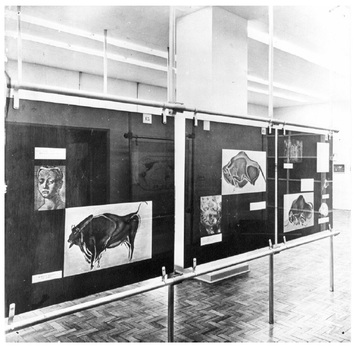
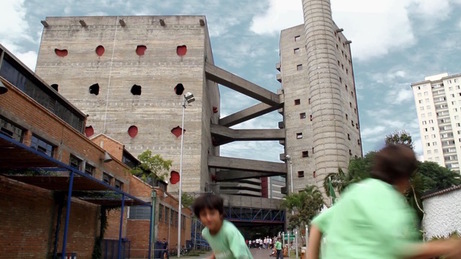
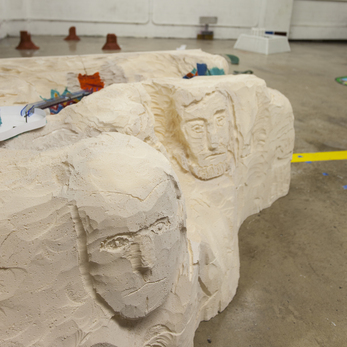
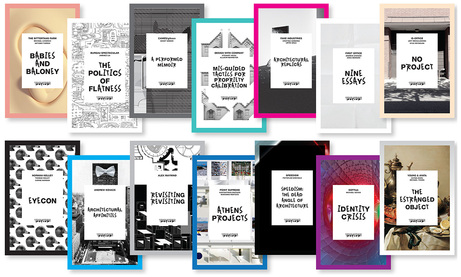
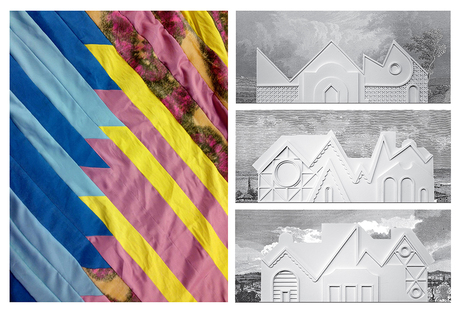
 PREVIOUS POSTS
PREVIOUS POSTS